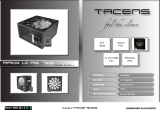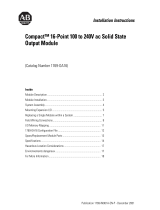
i Publication 1756-RM084F-EN-P - July 2002
Table of Contents
Chapter 1
Importing and Exporting Files
Introduction . . . . . . . . . . . . . . . . . . . . . . . . . . . . . . . . . . . 1-1
Importing a Complete Text File into a Project. . . . . . . . . . . 1-2
Exporting a Complete Project to a Text File . . . . . . . . . . . . 1-3
Importing a Tags Text File into a Project . . . . . . . . . . . . . . 1-4
Exporting Tags to a Text File. . . . . . . . . . . . . . . . . . . . . . . 1-6
Selecting the scope of the tags to export. . . . . . . . . . . . 1-6
Chapter 2
Structuring a Complete (.L5K)
Import/Export File Format
Introduction . . . . . . . . . . . . . . . . . . . . . . . . . . . . . . . . . . . 2-1
Conventions . . . . . . . . . . . . . . . . . . . . . . . . . . . . . . . . . . . 2-1
Internal file comments . . . . . . . . . . . . . . . . . . . . . . . . . 2-1
Placing Information in an Import/Export File . . . . . . . . . . . 2-2
Display style . . . . . . . . . . . . . . . . . . . . . . . . . . . . . . . . 2-3
Component descriptions. . . . . . . . . . . . . . . . . . . . . . . . 2-3
Defining a Controller. . . . . . . . . . . . . . . . . . . . . . . . . . . . . 2-4
Specifying CONTROLLER attributes. . . . . . . . . . . . . . . . 2-5
CONTROLLER guidelines . . . . . . . . . . . . . . . . . . . . . . . 2-6
CONTROLLER example . . . . . . . . . . . . . . . . . . . . . . . . 2-6
Chapter 3
Creating a Complete
Import/Export File
Introduction . . . . . . . . . . . . . . . . . . . . . . . . . . . . . . . . . . . 3-1
Defining a Data Type . . . . . . . . . . . . . . . . . . . . . . . . . . . . 3-1
Specifying DATATYPE attributes. . . . . . . . . . . . . . . . . . 3-2
Specifying a DATATYPE member . . . . . . . . . . . . . . . . . 3-2
Specifying DATATYPE member attributes . . . . . . . . . . . 3-4
DATATYPE guidelines . . . . . . . . . . . . . . . . . . . . . . . . . 3-4
DATATYPE example . . . . . . . . . . . . . . . . . . . . . . . . . . 3-4
Defining a Module . . . . . . . . . . . . . . . . . . . . . . . . . . . . . . 3-5
Specifying MODULE attributes . . . . . . . . . . . . . . . . . . . 3-5
Specifying a MODULE connection list. . . . . . . . . . . . . . 3-7
Specifying MODULE connection list attributes . . . . . . . . 3-8
MODULE guidelines. . . . . . . . . . . . . . . . . . . . . . . . . . . 3-8
MODULE example . . . . . . . . . . . . . . . . . . . . . . . . . . . . 3-8
Defining a Tag . . . . . . . . . . . . . . . . . . . . . . . . . . . . . . . . . 3-10
Defining a TAG declaration for a non-alias tag . . . . . . . 3-11
Defining a TAG declaration for an alias tag. . . . . . . . . . 3-12
Defining an array specification . . . . . . . . . . . . . . . . . . . 3-12
Specifying TAG attributes . . . . . . . . . . . . . . . . . . . . . . . 3-13
Defining TAG initial values. . . . . . . . . . . . . . . . . . . . . . 3-28
Defining a comment for a TAG component. . . . . . . . . . 3-29
TAG guidelines . . . . . . . . . . . . . . . . . . . . . . . . . . . . . . 3-30
TAG examples. . . . . . . . . . . . . . . . . . . . . . . . . . . . . . . 3-30
Spare Allen-Bradley Parts























